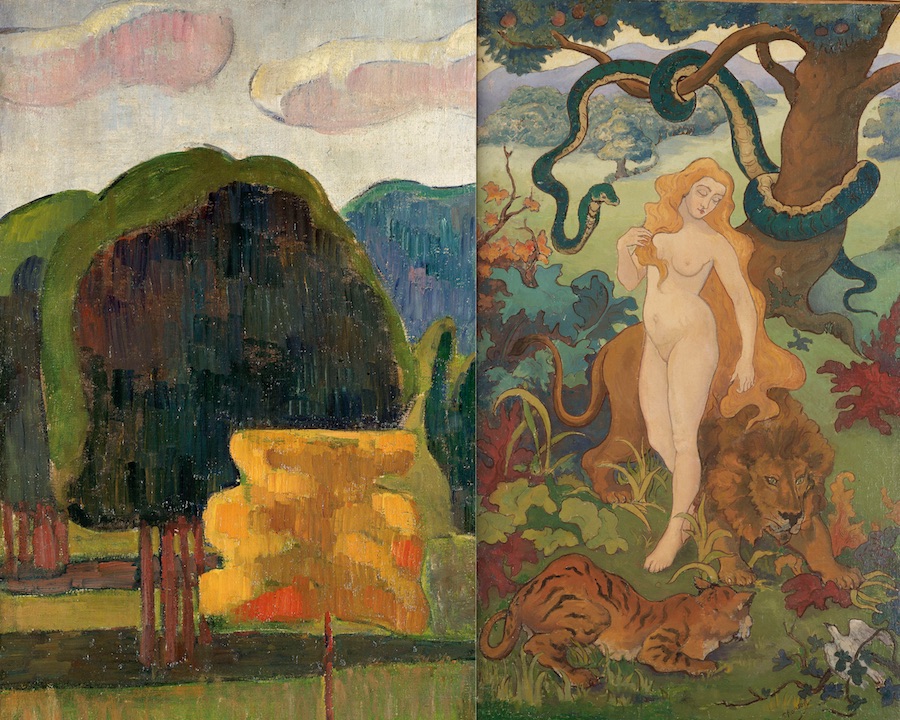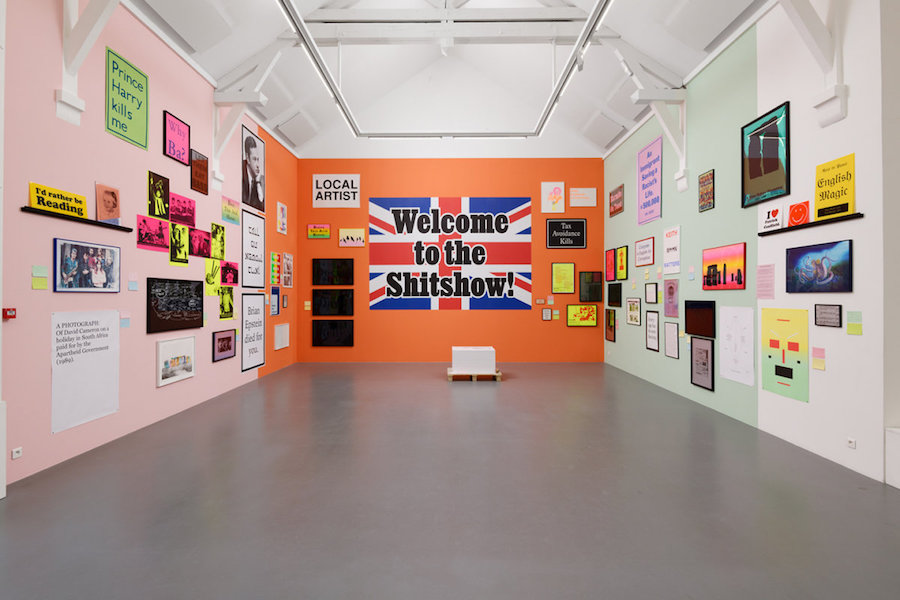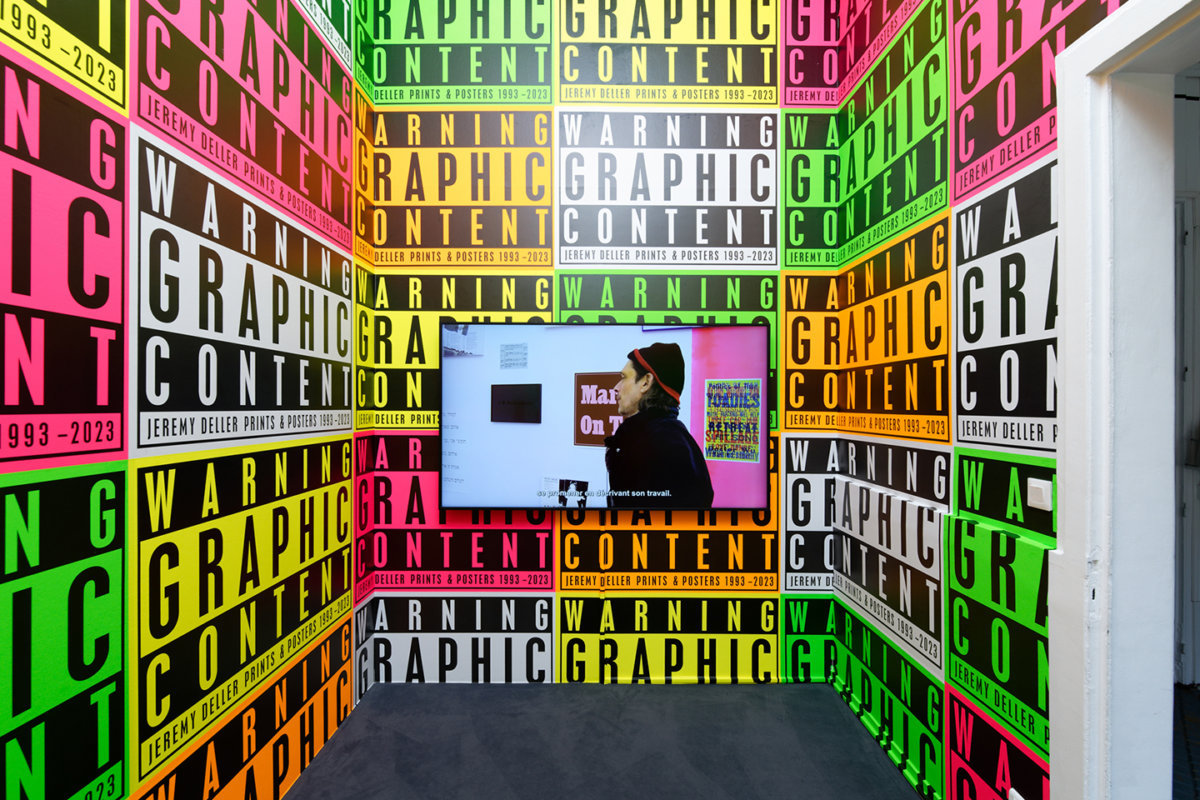Brittany played a significant role in developing Post-Impressionism and Pictorial Symbolism, with its Catholic culture a source of inspiration and Catholic artists among its pioneers. Several artists also contributed to reviving sacred art in Europe whilst offering or creating work for local churches. The visual arts remain significant for Brittany through collections of Post Impressionist work and contemporary exhibitions such as the current retrospective of the Turner Prize-winning British artist Jeremy Deller in Rennes.
Pont-Aven is the catalytic location, a village in the west of Brittany clustered around a bridge spanning the river Aven and set in a deep valley surrounded by attractive hills and woods. The village was already an artist’s colony when Paul Gauguin arrived in late July 1886. In August, he first met Émile Bernard, who, having been expelled from the Atelier Cormon in Paris for insubordinate behaviour, had begun a six-month walking tour through Normandy and Brittany. MaryAnne Stevens noted that this ‘voyage à pied’ awakened a “lifelong love for the latter region’s art and architecture, customs, traditions and faith”. He met Gauguin’s friend, the stockbroker and painter Emile Schuffenecker, painting on the beach in Concarneau (another local artist’s colony). Consequently, Bernard also arrived in Pont-Aven.

Bernard is again in Brittany the following year, firstly at Saint-Briac on the northern coast and then at Pont-Aven, where he hopes to see Gauguin. Gauguin, however, is in Martinique, so it is not until 1888, prompted by Vincent Van Gogh, that the two re-connect in Pont-Aven. Bernard, by this time, has developed, together with Louis Anquetin, the Cloisonism style through, as Belinda Thomson has described, “the use of simple outlining and blocked colour”, drawing on the influence of Japanese prints and stained glass. Bernard makes a positive impression on Gauguin, who, when writing to Van Gogh, says that he finds Bernard intriguing as a personality and, in a letter to Schuffenecker, that Bernard had brought interesting work with him from Saint-Briac and is afraid of nothing. In the words of Gauguin, the two created “a distinct movement” over the summer of 1888; this movement was Synthetism or Pictorial Symbolism, which draws on the style of Cloisonism while being based on a rejection of realism and an embrace of ideas.
In doing so, both repeatedly turned to religious subject matter inspired, as Vojtěch Jirat-Wasiutyński has noted, by “local religious traditions and images”. In Bernard’s case, this increasingly becomes an attempt “to renew religious painting by the use of a modern formal language expressive of his sense of contemporary religious yearning”, while, for Gauguin, it is about the creation of “a new symbolism to visualise modern spiritual experience as he understood it”. The results include paintings such as Bernard’s ‘Breton Women in the Meadow / Pardon at Pont-Aven (1888), ‘Christ in Gethsemene (1889), ‘The Annunciation’ (1889), ‘Pieta (Deposition from the Cross)’ (1890) and Gauguin’s ‘Vision of the Sermon: Jacob Wrestling with the Angel’ (1888), ‘Christ in Gethsemene’ (1889), ‘Breton Calvary’ (1889) and ‘Yellow Christ’ (1889). Several of Gauguin’s works incorporate religious artefacts from the area – a crucifix and stone sculpture from Trémalo – while both paint local traditions, including Pardons and wrestling matches.
The impact of this new movement quickly spread as Gauguin was visited at Pont-Aven by the artist Paul Sérusier. Although an established artist in Paris, Sérusier was intrigued by Gauguin’s recent work and was given an impromptu lesson in synthesist painting in the Bois d’Amour, the ‘Wood of Love’, a walk among the trees and along the river, located on the heights of Pont-Aven. The painting Sérusier made under Gauguin’s instruction (‘Landscape in the Bois d’Amour’ 1888) was taken back to Paris and shown to Sérusier’s close colleagues at the Académie Julian. They renamed the painting ‘The Talisman’, which formed the basis of a new style and group known as Les Nabis (‘The Prophets’). The group included Pierre Bonnard, Auguste Cazalis, Maurice Denis, Paul Ranson, Ker-Xavier Roussel, Sérusier, Félix Vallotton, and Édouard Vuillard. In 1889 the group held its first exhibition at the Café des Arts, without the grounds of the Paris International Exposition. Titled ‘The Impressionist and Synthesist Group’, the exhibition also included works by Gauguin and Bernard.

Thomson notes that the religious work of Bernard and Gauguin from Brittany inspired “several religious paintings produced by these spiritually inclined artists”. These include Maurice Denis’ ‘Orange Christ’ (1890), ‘The Mystical Grape Harvest’ (1890), ‘Jacob Wrestling with the Angel’ (1893) and Paul Ranson’s ‘Christ and Buddha’ (1890) and ‘Eve’ (1895). A later Nabi, Jan Verkade, entered religious orders at the Beuron Monastery, where its art school was led by Fr Desiderius Lenz. Sérusier, after visiting Beuron, permeated his work with religious symbolism, including an exploration of the Golden Mean. At the same time, Denis, who was exceptionally influential as an artist and theorist, set up the Ateliers d’Art Sacré (Studios of Sacred Art) with George Desvallières. Through his Ateliers, Denis contributed to a revival of French Sacred Art, thus making Gauguin and Bernard important precursors of that same revival.
The work of these artists can be seen in museums around the region at Brest, Le Faouët, Pont-Aven, Quimper and Rennes. At Pont-Aven, a tour of the town takes in the history of the port in the nineteenth century, the mills and galettes, the bridge, the places where painters stayed, including the Gloannec guesthouse and the Hôtel Julia, the parish church, and the Xavier Grall path leading to the Bois d’Amour. Also on the walk is the chapel of Trémalo, within which the wooden polychrome Christ-inspired Gauguin’s ‘Yellow Christ’ can be seen.
Sérusier summered in the inland town of Huelgoat from 1891 to 1893. There, he discovered the many legends connected with Breton forests, particularly those concerned with the ancient Brocéliande. The Monts d’Arrée, with their rocky formations and legends, inspired some unique paintings imbued with archaic spirituality, including ‘The Incantation, or The Sacred Wood’ (Musée des Beaux-Arts de Quimper) and ‘Solitude’ (Musée des beaux-arts de Rennes). In 1893, he settled in Châteauneuf-du-Faou, a little town overlooking the Aulne, which inspired him until his death. A walking tour can be followed to see scenes painted by Sérusier while a Musée Paul Sérusier is being built.
Denis considered the Pink Granite Coast at Ploumanac’h and Perros-Guirec paradise and bought Villa Silencio at Pointe du Château in Trestrignel. With his brush strokes, regattas, bathers and family seaside scenes became the pretext for expressive and poetic paintings that demonstrated astonishing decorative inventiveness (see, for example, ‘Les Premiers Pas’, 1911, Musée des beaux-arts de Rennes). Works from these artists’ revival of French Sacred Art were also created in the region. These include ‘Stations of the Cross’ painted by Denis in 1931 for Notre Dame de La Clarté at Perros-Guirac.
In 1905, Sérusier proposed a mural scheme for the vaults of St Julian Church in Châteauneuf-du-Faou. These were to be frescos in tempera on the themes of ‘Moses and the Burning Bush’, ‘The Annunciation to Mary’ and ‘The Adoration of the Shepherds and Magi’. He prepared sample canvases, but these were rejected, as Jean-Pierre Colivet suggests, for aesthetic reasons or “so as not to enter into open conflict due to the tensions between the Church and the State in 1905” or on the grounds of cost. They can now be viewed in a corridor of the former Augustinian monastery of Guingamp, which today is the Town Hall. However, a few years later, Fr Jean Fortin asked Sérusier to create baptistery decorations in a small chapel sheltered by the church. From 1914 to 1919, these murals were completed and depicted ‘The Annunciation’, ‘The Assumption’, ‘The Baptism of Christ’, ‘The Last Supper’, ‘The Crucifixion’, and ‘The Resurrection’.
Taking us back to the beginning of this period, in 1888, before meeting Gauguin in Pont-Aven, Bernard stayed in Saint-Briac for three months and, in that time, painted murals of ‘The Adoration of the Shepherds’ and ‘The Circumcision’, as well as painting windows as stained glass. Some drawings and photographs exist, but the originals are either lost or covered. There is a continuing dispute over the lodgings in which Bernard stayed, where the murals were painted, and whether the murals still exist today, albeit covered by paint.

A contemporary equivalent to the anthropological investigations and paintings of the Symbolists in Brittany can currently be seen in Rennes. ‘Art is Magic’ is the first French retrospective of Jeremy Deller, whose work explores the social history of the United Kingdom and further afield, dealing primarily with popular culture and counter-cultures.
Providing a broad overview of Deller’s work from the 1990s to today, ‘Art is Magic’ focuses on 15 major projects and critical positions that have marked his career and showcase his artistic inquiries. These centre on social issues, history and music through subjects as diverse as the social unrest of the Thatcher era, the pop group Depeche Mode, the world of wrestling, the spawning ground of Brexit, acid house and the rave movement. His work is collaborative, as he has constantly endeavoured to include other participants in his creative processes. His oeuvre is tinged with acerbic humour and conscious socio-political discourse, connecting vernacular or mass culture and the worlds of work.
The retrospective is spread across three venues. The Rennes Museum of Art exhibition gives an overview of Deller’s creative output since the 2000s with work combining performative art, video and installation. ‘Valerie’s Snack Bar’ and ‘Speak to the Earth and It Will Tell You’ explore social cohesion, the ties that bind people together. ‘The Battle of Orgreave’ and ‘Putin’s Happy’ are presented as anthropological tools for investigating and examining political struggle and its treatment by the media, from the social conflict of the Thatcher years to more recent debates about Brexit.
This historical context — political, social and artistic — is also in evidence at La Criée Centre of Contemporary Art with ‘Warning Graphic Content’, a collection of Deller’s poster and print work from 1993 to 2021 that features over 100 pieces. The ‘all-over’ hanging here, which is lawless and slightly chaotic, plays with different formats, colours and heights. This is a visual means used by the curators to highlight the disrupting of boundaries and codes achieved by these posters through their “blend (as topical as it is cheeky) of poetry and polemic, the universal and the private, the local and the global, and tenderness and irony”. In direct response, the voice-over in Deller’s slideshow ‘Beyond the White Wall’ recounts his projects undertaken in the public space that blur the boundaries between the space of art and the social space.
Deller’s posters and collages reveal him, as one born in the 1960s, to be a worthy heir to pop art. The curators note that “his art inherits certain important features from Pop Art” and that his meeting with Andy Warhol in 1986 represented a turning point for him. Pop Art itself is explored through a separate exhibition in Rennes, ‘Forever Sixties: The Spirit of the Sixties in the Pinault Collection’ which includes works by Richard Avedon, Gilbert & George, Richard Hamilton, Duane Hanson, Barbara Kruger, Michelangelo Pistoletto, Ed Ruscha and Niki de Saint Phalle, among others. When combined with Deller’s retrospective, one can travel from the Sixties pop culture to the present.
Finally, the exhibition at Frac Bretagne presents Deller as the great observer of vernacular culture in the UK. ‘Folk Archive’ (2005 with Alan Kane) combines drawing, painting, film, performative art, costume, decoration, political opinions, humour, and some surprising objects. Here we find pieces by men and women prisoners and community groups, troupes of performers from the Notting Hill Carnival, protesters, pop fans, bored teenagers, villagers and the homeless. The work finds creative practices and artefacts beyond the mainstream art world, celebrates a vast range of British pastimes and pursuits, and demonstrates that folk art in Britain is widespread and in good health.
As a counterpart to this installation, three films address the appropriation of popular culture: ‘English Magic’ (2013), ‘Everybody in the Place: an Incomplete History of Britain 1984-1992’ (2018) and ‘Our Hobby is Depeche Mode’ (2006, with Nick Abraham). ‘English Magic’ reflects the roots of Deller’s work, concentrating on British society — its people, icons, myths, folklore, and cultural and political history – while forging links between the high and the low, the popular and the oddball. ‘Everybody in the Place’ scrutinises the explosion of acid house and rave music in the UK as a reaction to deep-seated failings in British culture. ‘Our Hobby is Depeche Mode’ tells a tale that turns bizarre, funny, sad and often touching, reflecting on how people intimately embrace and appropriate pop culture in their own lives.
Deller regularly sabotages the status of the creative artist by incorporating all kinds of people into the creative process. With each of his experiments, he humorously restates his sense of wonder at counter-cultures, anonymous inventiveness and the rebellious power of people. He states, “Art is a form of magic that has this alchemical power to transform the everyday, to give depth to what at first glance may seem mundane or superficial, even if the experience only turns out to be fleeting.” This, too, would seem to be a point of connection with Brittany’s Symbolist painters and a continuation of their vision.
Top Photo: Jeremy Deller, installation view Warning Graphic Content, La Criée centre for contemporary art, exhibition Art is Magic, Rennes 2023
Courtesy the artist; The Modern Institute / Toby Webster LTD, Glasgow; Art: Concept, Paris © Jeremy Deller – photo: Auélien Mole
In the footsteps of painters in Brittany
‘Art is Magic: Jeremy Deller’, from 10 June to 17 September 2023, Frac Bretagne, La Criée centre d’art contemporain, Musée des beaux-arts, Rennes

